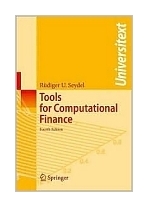This book is very easy to read and one can gain a quick snapshot of
computational issues arising in financial mathematics.
Researchers or students of the mathematical sciences with an interest in
finance will find this book a very helpful and gentle guide to the world of financial
engineering. SIAM review (46, 2004).
The fourth edition is thoroughly revised and extended. Major revisions concern
topics like calibration, Monte Carlo Methods, American options, exotic options and
Algorithms for Bermuda Options.
New figures, more exercises, more background material make this guide to the
world of financial engineering a real must-to-have for everyone working in FE.
Prefaces
Contents
Notations
Chapter 1 Modeling Tools for Financial Options
1.1 Options
1.2 Model of the Financial Market
1.3 Numerical Methods
1.4 The Binomial Method
1.5 Risk-Neutral Valuation
1.6 Stochastic Processes
1.6.1 Wiener Process
1.6.2 Stochastic Integral
1.7 Diffusion Models
1.7.1 It^o Process
1.7.2 Geometric Brownian Motion
1.7.3 Risk-Neutral Valuation
1.7.4 Mean Reversion
1.7.5 Vector-Valued SDEs
1.8 It^o Lemma and Applications
1.8.1 It^o Lemma
1.8.2 Consequences for Stocks and Options
1.8.3 Integral Representation
1.8.4 Bermudan Options
1.8.5 Empirical Tests
1.9 Jump Models
1.10 Calibration
Notes and Comments
Exercises
Chapter 2 Generating Random Numbers with Specified Distributions
2.1 Uniform Deviates
2.1.1 Linear Congruential Generators
2.1.2 Quality of Generators
2.1.3 Random Vectors and Lattice Structure
2.1.4 Fibonacci Generators
2.2 Extending to Random Variables From Other Distributions
2.2.1 Inversion
2.2.2 Transformations in IR1
2.2.3 Transformation in IRn
2.3 Normally Distributed Random Variables
2.3.1 Method of Box and Muller
2.3.2 Variant of Marsaglia
2.3.3 Correlated Random Variables
2.4 Monte Carlo Integration
2.5 Sequences of Numbers with Low Discrepancy
2.5.1 Discrepancy
2.5.2 Examples of Low-Discrepancy Sequences
Notes and Comments
Exercises
Chapter 3 Monte Carlo Simulation with Stochastic Differential Equations
3.1 Approximation Error
3.2 Stochastic Taylor Expansion
3.3 Examples of Numerical Methods
3.4 Intermediate Values
3.5 Monte Carlo Simulation
3.5.1 Integral Representation
3.5.2 Basic Version for European Options
3.5.3 Bias
3.5.4 Variance Reduction
3.5.5 Application to an Exotic Option
3.6 Monte Carlo Methods for American Options
3.6.1 Stopping Time
3.6.2 Parametric Methods
3.6.3 Regression Methods
3.6.4 Other Methods, and Further Hints
Notes and Comments
Exercises
Chapter 4 Standard Methods for Standard Options
4.1 Preparations
4.2 Foundations of Finite-Difference Methods
4.2.1 Difference Approximation
4.2.2 The Grid
4.2.3 Explicit Method
4.2.4 Stability
4.2.5 An Implicit Method
4.3 Crank-Nicolson Method
4.4 Boundary Conditions
4.5 American Options as Free Boundary Problems
4.5.1 Early-Exercise Curve .
4.5.2 Free Boundary Problem
4.5.3 Black-Scholes Inequality
4.5.4 Obstacle Problem
4.5.5 Linear Complementarity for American Put Options
4.6 Computation of American Options
4.6.1 Discretization with Finite Differences
4.6.2 Reformulation and Analysis of the LCP
4.6.3 An Algorithm for Calculating American Options
4.7 On the Accuracy
4.7.1 Elementary Error Control .
4.7.2 Extrapolation
4.8 Analytic Methods
4.8.1 Approximation Based on Interpolation
4.8.2 Quadratic Approximation
4.8.3 Analytic Method of Lines
Notes and Comments .
Exercises
Chapter 5 Finite-Element Methods
5.1 Weighted Residuals
5.1.1 The Principle of Weighted Residuals
5.1.2 Examples of Weighting Functions
5.1.3 Examples of Basis Functions
5.2 Galerkin Approach with Hat Functions
5.2.1 Hat Functions
5.2.2 Assembling
5.2.3 A Simple Application
5.3 Application to Standard Options
5.3.1 European Options
5.3.2 Variational Form of the Obstacle Problem
5.3.3 American Options
5.4 Application to an Exotic Call Option
5.5 Error Estimates
5.5.1 Strong and Weak Solutions
5.5.2 Approximation on Finite-Dimensional Subspaces
5.5.3 C´ea’s Lemma
Notes and Comments
Exercises
Chapter 6 Pricing of Exotic Options
6.1 Exotic Options
6.2 Options Depending on Several Assets
6.3 Asian Options
6.3.1 The Payoff
6.3.2 Modeling in the Black-Scholes Framework
6.3.3 Reduction to a One-Dimensional Equation
6.3.4 Discrete Monitoring
6.4 Numerical Aspects
6.4.1 Convection-Diffusion Problems
6.4.2 Von Neumann Stability Analysis
6.5 Upwind Schemes and Other Methods
6.5.1 Upwind Scheme
6.5.2 Dispersion
6.6 High-Resolution Methods
6.6.1 Lax-Wendroff Method
6.6.2 Total Variation Diminishing
6.6.3 Numerical Dissipation
Notes and Comments
Exercises
Appendices
A Financial Derivatives
A1 Investment and Risk
A2 Financial Derivatives
A3 Forwards and the No-Arbitrage Principle
A4 The Black-Scholes Equation
A5 Early-Exercise Curve
B Stochastic Tools
B1 Essentials of Stochastics
B2 Advanced Topics
B3 State-Price Process .
B4 L´evy Processes
C Numerical Methods
C1 Basic Numerical Tools
C2 Iterative Methods for Ax = b
C3 Function Spaces
C4 Minimization
D Complementary Material
D1 Bounds for Options
D2 Approximation Formula
D3 Software
References
Index .
336 p. 85 illus.,Paperback
Księgarnia nie działa. Nie odpowiadamy na pytania i nie realizujemy zamówien. Do odwolania !.


